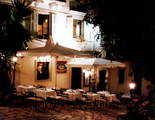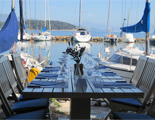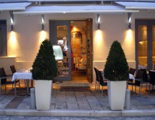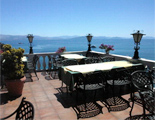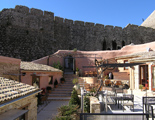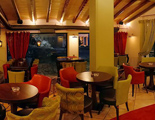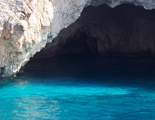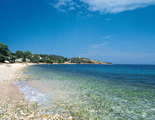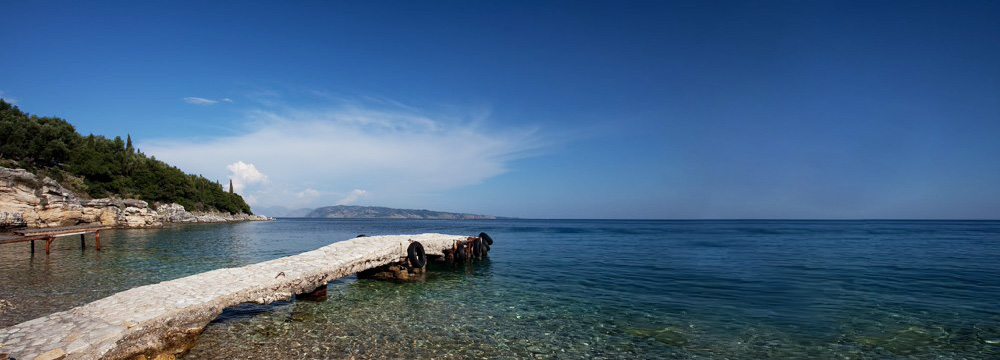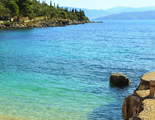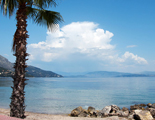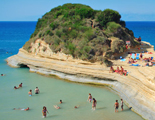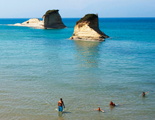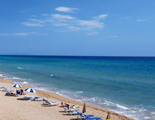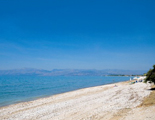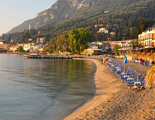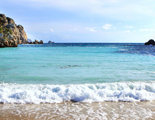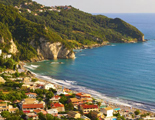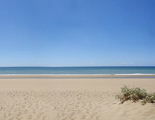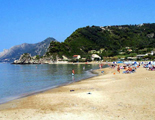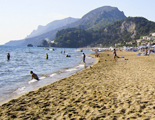 Corfu Travel Guide
Corfu Travel Guide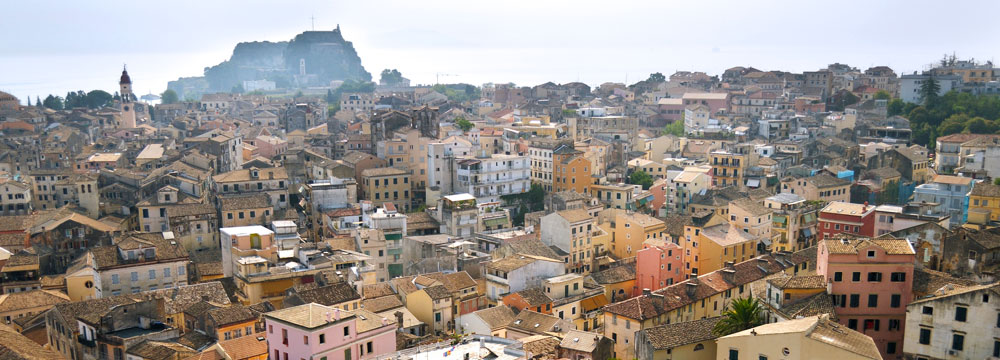
Corfu’s long and turbulent history has contributed to the island’s intriguing, charming and somewhat mystifying character.
Corfu was not always an island. During the Paleolithic era, Corfu was part of Greece’s mainland; the geographical separation took place during the Neolithic era (10.000-8.000 BC) when the ice melted and the level of the sea rose creating an independent island. Traces from that era can be found in Sidari. On the northwest side of the island, in Kefali, Afionas and Ermones, archeological excavations uncovered few Bronze Age settlements from the 2nd century BC.
The first Greek settlers of the island were Eretrians from Evia Island, around 775-750 BC. A few years later, the Eretrians were joined by political refuges from Corinth who brought with them their highly developed political outlook and founded the ancient city of Palaiopolis. Under Heriscrates leadership, Corfu became an important commercial center with a strong naval force, independent from Corinth. The strong political power however divided the island into two; the Democrats and the Oligarchs.
The Democrats and Oligarchs cohabited Corfu peacefully for 300years, before falling into conflict over a jointly-held colony, Epidamnos (Durres). Corfu requested support from the Athenians, giving rise to the well-known Peloponnesian wars. Corfu’s alliance with Athens lasted a century until 338 BC, when the Macedonians under King Philip II dissolved the alliance and took control. King Philip II domination was followed by the Spartans, the Syracusians, the Illyrians and finally the Romans in 229 B.C.
Corfu was the first Greek territory to full under Roman rule. Together with the Oligarchy, the Romans created their own aristocracy and subjected the island into a state of deep recess. Under the Romans reign, roads and public buildings were built and Christianity was introduced by the disciples of Saint Paul, Jason and Sosipatros. Corfu was one of the first Greek cities to convert to Christianity. Sometime thereafter, Caesar Nero’s persecution of all Christians brought a division to the Roman Empire; Corfu was ceded to the Eastern Roman Empire and left to the mercy of barbarian raids by the Vandals of Genzerichou, Goths and finally the Saraceans who were expelled in 733 A.D.
Corfu was inhabited for several centuries after by the Byzantine Orthodox, the Normans, and the Franks before falling under the Venetian rule.
The Venetian domination determined Corfu’s unique character as it did not endure the control of the Ottomans that overwhelmed the rest of Greece. The Venetians ruled Corfu for four centuries, under which the Corfiots enjoyed a highly intellectual life. The existing system was strengthened by the Libro d’Oro (nobility), new social classes emerged, the ‘civili’ (bourgeoisie) and the ‘popolari’ (common people), commerce and agriculture reached their highest peak and culture flourished. Corfu’s intellectual awakening can be marked by the many literary and artistic personas that inhabited the island.
In 1797, Venice surrendered to Napoleon Bonaparte’s empire and Corfu became part of the French state. The ideology of the French Revolution inspired the locals who began dreaming of their own independence; the Tree of Freedom was planted in Esplanade square, the ‘Libro d’ Oro’ book burnt and emblems of Venetian rule destroyed. In 1890 the Palace of Empress Sissy was built as a refuge from the conspiracies of the Hapsburg court. The palace then became the setting of the Bella Venezia Hotel, a beautiful hotel often compared to the Grand Bretagne of Athens.
In 1814 the Ionian Islands were declared an independent state, under the British rule. The economy fully recovered; an extended road network was constructed, the first Greek University, the Ionian Academy, was established (1824) and Greek became the official language of the island. The British remained in Corfu until 1864, when the Ionian Islands were united with the rest of Greece.
Corfu’s independence brought a change to the Ionian state capital who could no longer afford the existence of two separate centers of culture and wealth. The Ionian University and other cultural institutions were sacriviced and in WWII, the occupation of the Italians and Germans demolished the Ionian Academy, the Library and the Municial Theatre, crippling Corfu’s arts.
Corfu shared the misfortune with the rest of Greece in the years that followed WWII, until the late 1960s, when tourist development gave a new movement to the economic and social life of the country. The island's natural beauty was undeniable. Up until WWII, Corfu rivaled Capri and Majorca as amongst the favorite Mediterranean destinations of the European elite. During the last 40 years, the excellent tourism infrastructure, the historic past and the natural beauty of the island made it one of the most popular holiday destinations.
The history of Corfu (Kerkyra in Greek), like that of many islands in the Ionian and Aegean Sea, is shrouded with myths, tales, and legends and of course battles and conquests. Corfu is an island tales strongly linked to two powerfully mythical water entities: Poseidon, the God of Sea and the God Asopos, the famous river located in Viotia. Below are only few of the memorable myths that revolve around the beautiful island of Corfu.
Corfu played a protagonist role in Homer’s Odyssey as the island where Odysseus washed up on shore after his escape from Calypso. Led by Athena, the Goddess of Wisdom and War, princess Navsika the daughter of the royal couple Alkinou and Arites, rescued Odysseus and supplied Odysseus with a ship for his journey back to Ithaka.
Poseidon was furious when he found out and petrified the boat just off the location of Palaiokastritsa, where Alkinoos’ Palace was built. There are other arguments that state the ship collided into Pontikonisi, a small islet near Corfu after a serious thunderstorm caused by Poseidon.
Corfu is also mentioned in the 3rd century BC Greek epic poem, The Argonautika, written by Apollonius the Rhodes. Written before Odysseus sea adventure, the myth is about Jason and his journey to retrieve the Golden Fleece from the mythical land of Colchis. The third book tells the story of Jason and Medea, the daughter of King Colchis who elope and take refuge at Alkinoos Palace in Kerkyra.
The existence of the Phaecian civilization and Alkinoos Palace remain a mystery till today. Archaeologists suggest that Scheria (Palaiokastritsa, Ermones) could be the area mentioned in both epics. Nothing has been confirmed, since findings from the Mycenaean Era (which Homer refers to) are extremely limited.
There are many legends regarding the origins of the islands’ name. In Ancient times the island was referred to as, Makris (long), Drepani (sickle) and Harpi (harp) due to its long curved shape and Scheria (endless coast) the Homeric island settled by the Phaecians.
Some centuries later, the island adopted the Greek name ‘Kerkyra’ from a love story between the nymph Korkyra, the daughter of the river god Asopos and the God Poseidon. According to myth, Poseidon fell in love with Korkyra and brought her to the island where she gave birth to Phaekas, the island’s first mythical king. In Homer’s epic, Corfu is referred to as Phaekia, after the the Phaekian kingdom.
Corfu’s origin is of Byzantine decent from the word Koryfo (top) after the two peaks found in the island’s capital. From Koryfo came the Latin Corfu, a name that nowadays is recognized worldwide.
The most popular attraction in Corfu; the evergreen estate of Mon Repos is located in Palaiopoli, about 3km from Corfu Town and has a truly outstanding sea view.
This is where Frederick Adam, the High Commissioner of Eptanisa, built his summer estate in 1831. In 1864 the Palace was granted to King George I and the legendary Princess Elizabeth (Sissy) also stayed there. In this very palace, Philip Mountbatten, the Duke of Edinburg and spouse of Queen Elizabeth, was born. The architecturally impressive colonial style with neoclassical and Greek elements is surrounded by lush gardens with more than 2.000 species of plants, mostly gifts from royal families.
Visitors will be enchanted by the two famous statues of Achilles, located in the gardens, just outside the palace; the “Dying Achilles” by Ernst Herter and a huge statue of Achilles the Triumphant. Scenes from the James Bond movie “For Your Eyes Only” were also shot there.
The palace is open daily, except from Monday, from 8.30 in the morning until 15.00 in the afternoon.
Having adopted its name from its peculiar shape resembling a mouse, the small islet is Corfu’s landmark. The vegetated rock in the middle of the sea has been declared as an open natural museum and can be visited by a small boat from Kanoni, just outside the famous church of Virgin Mary Vlaherna. If you happen to be in Kerkyra during the Metamorphosis of Jesus Christ (August 6th) you are in luck as it is the only day visitors are able to visit the islet and the Byzantine monastery of Pantokratoras, which is the only building standing there.
This is one of the most important Metabyzantine monuments in the city of Corfu, built in 1589 and located at the Old Town (a few minutes from Spianada and Liston). It has an amazing marble temple, the relics of the Saint are kept in a silver crypt of the 19th century and it has some astonishing frescoes and golden panels all around. Agios Spyridonas is the patron saint of the island and they say he saved the inhabitants from the plague epidemic. The church’s bell tower is the tallest on the island.
The Fortezza is located on the east part of the city and it’s an architectural masterpiece of the Byzantine and the Venetian era. Inside you will see a Venetian prison, two British barracks and a military hospital, which now hosts the music school. Enjoy the breathtaking view of the Old Town, the sea and the small port with the fishing boats.
Dominating the hill of San Marco, the New Fort was built by the Venetians (16th century), after it was decided that the Old Fort wasn’t providing enough protection in the city. It’s said that in order to find the necessary building material, the architect Francisco Vitelli had to demolish 2.000 houses and churches.
The Old and the New Fort are still connected by underground channel that are now closed to the public. In its massive gate, visitors will see the amazing sculpture of a Lion, an emblem that will always be linking this Fort to Venice. Today, the New Fort hosts many cultural events, art exhibitions and concerts.
The Museum of Asian Art (the only Asian art museum in Greece), is housed in a beautiful building of the British Protectorate, designed by George Whitmore. Initially it was the residence of the High Commissioner and then as the headquarters of the Knights of St. Michael and St. George. The museum hosts about 11.000 items of statuettes from China, bronze ritual vases, masks from the No Theater, Greek-Buddhist sculptures, nephrite objects, Chinese porcelain items and samurai armors.
Winter and summer operating hours differ (Monday it’s always closed), for exact details call 22610 30443.
Founded in 1836 during the English Protection, the Reading Society’s Library is the oldest intellectual institution in Greece. The library houses rare editions, valuable manuscripts, maps, engravings, newspapers, booklets and photographs, related to the history of the Ionian Islands and an incredible collection of paintings and icons.
Open daily from 9am till 2pm (except Sundays).
The church of Panagia Antivouniotissa located in the Old Town, was built around the 15th century and is the oldest church in the city. It hosts some amazing icons of Virgin Mary, Agios Sergios, Agios Dimitrios and of Kyrillos Alexandrias.
Open daily from 8.30am till 3pm (except Mondays).
A cosmopolitan spot, with a magical sea view overlooking the islet of Vlaherna and the famous Pontikonisi, the town derived its name from the original French canon located just in the middle of the little square. This is where the ancient city of Corfu (8th century BC) and the ancient temple of Artemis are located. The entrance to the legendary Casino is also there.
A place of rare natural beauty, just 26 km northwest from the city of Corfu, Palaiokastritsa consists of two long sandy beaches surrounded by astonishingly sculpted rocks with cold, emerald waters. The coast is ideal for diving and snorkeling, due to the numerous coves and the underwater caves. Scenes from the James Bond movie “For Your Eyes Only” were also shot here.
CLIMATE
The islands of the North Ionian Sea are somewhat isolated and the climate differs from the rest of Greece. There are no “meltemia”, the famous winds that blow in the Aegean Sea, during the summer months. The winds in Corfu are light and the climate is mild and sweet. Many tourists prefer this side of Greece, avoiding the strong winds of the Aegean.
During the winter months, southern winds, usually lasting for days, strike the island with an intensity that can reach up to 8 Beauforts. The strong winds rarely cut off access to the mainland, due to the small distance from the shores of Epirus. The island also experiences high humidity and heavy rain falls, during the witner months, which explain its rich vegetation.
TELEPHONE
The national prefix for Greece is +30 if you are calling from abroad.
The area codes for Corfu are 26610, 26620 and 26630 and the local phone numbers have 5 digits. If you wish to call abroad, you have to start by dialing the other country’s national prefix (i.e. for Germany is 0049, for England is 0044, etc.) and then continue with the desired area code and number.
CURRENCY
The currency of the island is Euro (€). Euro Coins: 1 and 2 euro coins (gold and silver color) 10, 20 and 50 cents (gold color) 1, 2 and 5 cents (copper color) 1 euro = 100 cents/centimes.
The banknotes come in 5, 10, 20, 50, 100, 200 and 500. Please bear in mind that it’s not always easy to get change from 100, 200 and 500 banknotes.
Kerkyra is one of the most popular destinations in Greece. Every year the island welcomes an enormous number of tourists, who come from every part of the world, but mainly from Europe. This is why it’s very well connected with the mainland, as well as with numerous countries, by air and by sea.
Kerkyra is connected by boat from:
• Igoumenitsa (within an hour and a half – 14 nautical miles)
• Patra (within 7-8 hours)
• Kefalonia, the Diapontian Islands
• Paxoi Islands (within one hour – 27 nautical miles
• Bari, Venice, Ancona and Brindisi in Italy and Agioi Saranta in Albania (within 30 minutes)
During the summer months there are frequent commercial and charter flights that connect the island with almost every European capital.
BY BOAT
Blue Star Ferries – From Patra, Igoumenitsa, Corfu, Bari, Ancona and Venice. For accurate timetables and tickets visit the company’s website at www.bluestarferries.gr.
Superfast Ferries – From Patra, Igoumenitsa, Corfu, Bari and Ancona. For accurate timetables and tickets visit the company’s website at www.superfast.com
Minoan Lines – From Patra, Igoumenitsa, Corfu, Venice and Ancona. For accurate timetables and tickets visit the company’s website at www.minoan.gr
Anek Lines – From Patra, Igoumenitsa, Corfu, Ancona and Venice. For accurate timetables and tickets visit the company’s website at www.anek.gr
Ventouris Sea Lines – From Igoumenitsa to Corfu, Bari and Durres (Albania). For more information and contact details visit the company’s website at www.ventouris.gr
Endeavor Lines – From Patra, Igoumenitsa, Kefalonia, Corfu and Brindisi. For more information and reservations visit the company’s website at www.endeavor-lines.com
Petrakis Lines – From Corfu and Paxoi Islands. For more information call at +30 26610 31649 or 26610 38690
Corfu Flying Dolphins – From Corfu, Igoumenitsa and Paxoi Islands. For more information call at +30 26610 31649 or 26610 38690
BY AIR
Aegean Airlines – From Athens International Airport El. Venizelos to Corfu within approximately 45 minutes. For timetables, prices and reservations please visit the company’s website at www.aegeanair.com. Local telephone number (at Corfu Airport): +30 26610 27100
Olympic Airlines – From Athens International Airport El. Venizelos to Corfu within approximately 45 minutes. For timetables, prices and reservations please visit the company’s website at www.olympicair.com. Local telephone number: +30 26610 38694
BY CAR
If you are travelling by car, there are many alternatives to access Corfu.
If you are driving from Athens, you need to follow the Athens-Patra national highway towards Patra. Once you reach Patra (216 km) you have two choices; either go by boat or drive up to Igoumenitsa (another 349 km), passing the Rio-Antirio bridge. Once you reach Igoumenitsa, you can take the ferry to Corfu. The trip with the ferry lasts for about an hour and a half.
If you are travelling from Thessaloniki, you need to follow the Egnatia Odos towards Igoumenitsa (500 km) and then take the ferry to Corfu.
BUSES
The island has a very good road infrastructure and an excellent public transportation system. There are two available local bus lines.
The first is the municipal line (blue buses) and runs between the capital city of Kerkyra and the suburbs of Afra, Agios Ioannis, Kanoni, Perama and Achillion.
The second is the KTEL line (green buses) and covers the entire island. With KTEL you can visit various towns and villages, like Lefkimi, Kavos, Karoussades, Agios Panteleimon, Agios Gordios, Glyfada and many more.
KTEL: +30 26610 30627 and 26610 39985
TAXI SERVICE
You can also get around the island by taxi. There are many taxi piazzas, in various central points of the island, like in San Rocco square and on Theotokis Street. You can also call for a radio-taxi (call at 26610 33811).
The fares are fixed between the capital city and the most popular destinations, but you can also check before you get onboard. In the main piazzas you will also find a board with indicative fares for each destination. Finally, you can also hail a taxi, if you don’t happen to be near a piazza. They will stop provided that they have no other passenger onboard.
HORSE CARRIAGES
Corfu is one of the few places in Greece where you will actually see horse carriages. This is probably the most romantic way to tour around the capital city. You can find them in Spianada –the main square- and at the old port. The tour can last up to 40 minutes and the driver will take you around the main sights of the city.
For any additional information you can call at +30 26610 24162.
RENT A CAR OR A MOTORBIKE
Kerkyra is a big island visited by thousands of tourists every year. It has many attractions, scattered around, ancient monuments, amazing beaches and an astonishing natural beauty all around. If you don’t travel there with you own car, you can rent one or a motorbike, from one of the numerous car rental agencies that can be found in all the major towns. Remember that during the months of May through September, Kerkyra is packed and you need to make a reservation well ahead. Finally, bear in mind that Easter is also a very busy period for the island, due to the religious and cultural festivities that take place.
The ground rules about renting a vehicle or a motorbike are as follows,
• You have to be 21 years old and you definitely need a valid driving license
• Insurance is optional. Make sure you check the condition of the car beforehand. If you sign for its mint condition, this is how you must return it, otherwise you will be charged with damages –unless you included full insurance in the original price.
• You need to return the car with as much gas as it had when it was delivered to youBe careful. No agency should withhold your driving license or ID card. These can only be photocopied, if necessary, and then delivered back to you. You should carry them at all times in case the police or any local authorities request them.
The road network of Corfu is pretty good; however, do not forget that it’s also an agricultural area. Tractors or other vehicles might appear out of nowhere and the same goes for animals and/or pedestrians. Do not violate the speed limits and do not park where not allowed. The municipal and the traffic police will most certainly write you a ticket. Bear in mind that parking is limited around the city and especially near the entrance of the old town –where absolutely no cars are allowed.
Same rules apply in case you are interested in renting a motorcycle or a scooter. Only in this case you need to be extra careful and always wear a helmet. Parking will certainly be easier!
BANKS & ATMs
You will find branches of all the major Greek banks on the island, like National Bank, Emporiki Bank, Piraeus Bank, Alpha Bank, Agricultural, Ioniki, Eurobank and many more. They are all open daily, from Monday to Thursday, from 8am to 2.30pm and on Friday from 8am to 2pm.
No bank is open during the country’s national and religious holidays. You will find ATMs all over the capital city of Corfu, as well as in every town and village, where you can get cash 24/7.
Remember that in order to get money you need to have a card linked to the PLUS, Cirrus or Maestro networks. Check with your local bank for details.
MONEY EXCHANGE
Banks exchange all major currencies and traveler’s cheques; the commission is always lower for cash. Post offices can also exchange cash, but not traveler’s cheques and usually charge lower commissions than banks.
Travel agencies and 5 star hotels exchange foreign currency and traveler’s cheques, but usually charge a higher commission. There are banknote exchange machines in most tourist areas.
There is also a dedicated exchange kiosk at the local airport, as well as at the Athens international airport El. Venizelos.
POST OFFICE
The Greek post is called ELTA. Post boxes in Greece are YELLOW and there are separate boxes for international and domestic mail. RED Post Boxes are rarer and they are used for URGENT mail. REGISTERED mail is handled by an employee at the Post Office and you shouldn’t forget to get a receipt.
POLICE STATION
Do not hesitate to call the Police in case of an accident or a criminal act. If you have a problem with your hotel you can contact the Tourism Police. There are several police stations around the island and you will see officers inspecting the streets at all hours.
Police telephone numbers
Corfu town: 26610 39509 (on Theotokis Square)
Palaiokastritsa: 26630 41203
Benitses: 26610 72222
Agios Matthaios: 26610 75113
Lefkimi: 26620 22222
Tourism Police telephone numbers
Corfu town: 26610 39503
Ipsos: 26610 93204
Traffic Police telephone numbers
Corfu town: 26610 39294
Karoussades: 26630 31233
MUNICIPALITY OF CORFU
Tel.: +30 26610 39424
• Post Office: 26610 25544
• Greek Tourism Organization (information): 26610 37520
• Airport: 26610 30180 and 38694
• UK Embassy: 26610 30055
• German Embassy: 26610 31450
• French Embassy: 26610 30067
• Italian Embassy: 26610 42433
• Belgian Embassy: 26610 33788
• Norwegian Embassy: 26610 39667
• Swedish Embassy: 26610 36421
• Port authority Corfu town: 26610 32655
• Port authority Palaiokastritsa: 26630 41297
• Coastguard: 26610 30481
INTERNATIONAL PRESS
You can find International Press (magazines and newspapers) almost anywhere around the island.
HEALTH
Corfu has a fully equipped hospital, located on 1 Andreadi Str. (+30 22610 88200). There are also several Medical Aid Stations around the island.
• Ipsos: 26610 93816
• Agios Matthaios: 26610 75110
• Lefkimi: 26620 22201
PHARMACIES
There are numerous pharmacies around the island, which are open Monday and Wednesday from 8.30am to 2.30pm and on Tuesday, Thursday and Friday from 8.30am to 2.30pm and from 5.30pm- to 8.30pm. However, you will also find limited pharmacies which are open during the weekend and throughout the night. A list of those pharmacies can be found on any pharmacy’s window around the island.
A very popular beach, especially amongst the British tourists. It's located on the southern part of the island and it's about 3 kilometers long. The beach has an excellent infrastructure, with many taverns, bars, clubs, beach bars, umbrellas, sunbeds, showers, international cuisine restaurants, fast foods and cafes. The waters are azure, cold, yet shallow. It's quite far from the capital city of the island, yet it's daily visited by hundreds of people who party until the small hours and enjoy the fine Ionian waters.
This is a nice sandy beach, ideal for those who enjoy some peace and quiet during their holidays. The beach has small pebbles, crystal clear waters, few villas and a couple of traditional taverns.
This is allegedly one of the nicest beaches of the island. It combines excellent water quality, with rich vegetation, scenic bays, cosmopolitan ambiance and high standard services. This is where the Rothschild's mansion is located, as well as other famous people's private residences.
This small seaside village was the main access and communication point in the beginning of the 20th century, when the road network was still underdeveloped. Next to the scenic port you will find an organized beach for unforgettable moments of rest and relaxation. The olive trees reach all the way to the water, which are crystal clear and quite cold! From there you can take a small boat and visit the Diapontian and the Paxoi Islands.
This is a very long sandy beach, stretching all the way to the homonymous bay. It's fully organized, with umbrellas and sunbeds, a diving center and the infrastructure for water sports. The nearby village is quite developed with many taverns, shops, snack and beach bars. The waters are particularly shallow. Enjoy the panoramic view while you are driving on the coastal highway towards the northern side of the bay.
At the far left of the beach of Sidari you will stumble across the Canal D' Amour (channel of love), which is really a tunnel in between two rocks. According to the legends, whoever swims from one side to the other will definitely find the love of his life. Some people say it's because if you swim there alone you will feel this internal need to mate!
Sidari is a traditional summer holidays seaside destination of Kerkyra. It has an amazing long sandy beach, with quiet, shallow, crystal clear waters and an excellnt infrastructure. There are many hotels, rooms to let, a nice shopping center, restaurants, taverns, bars and a waterpark.
The beach of Issos is located few kilometers south of Korission Lake. It's long, well organized, with lifeguards on duty and the opportunity for water sports. The sand is soft and golden and the waters are azure and shallow. On its southern part, there is a port, few taverns and rooms to let.
Acharavi is located on the north part of the island and it's a 3 kilometers long sandy beach. It's fully organized with umbrellas and sunbeds, showers and lockers. Even though it's cosmopolitan, it's pretty quiet, away from the main, busy coastal road, with shallow clear waters -ideal for families with young children. There are few restaurants, beach bars and many villas to rent. Visitors will also have the chance to exercise various water sports.
A beautiful, scenic seaside village with mazy narrow streets, Roman baths, excellent food and many bars that will keep you awake until the small hours. The beach is long and pebbly and it was actually Emperor Wilhelm's favorite! Keizer has build a bridge in this exact location, part of which is still standing there! It's organized with sunbeds and umbrellas and offers the opportunity for some water sports.
In Palaiokastritsa you will actually find 5 beaches, each one with its own character. The main one is under the monastery, it's long, sandy and fully organized. The other one is close to the small port and it's very popular during the summer and the other 3 are accessible only by boat. Two things you must remember about Palaiokastritsa. The waters are extremely cold and the underwater world is very interesting! There are small boats that tour you in the area, through the small coves with the turquoise waters and the numerous caves. There are few taverns, several souvenir shops and the oldest diving center of the island.
Agios Gordis is actually one of the biggest bays on the western side of the island, with easy access by public buses, taxis and private vehicles. It's a nice, long sandy beach, fully organized and offering the opportunity for all kinds of water sports. Ideal for those who love to walk on the beach and enjoy the emerald waters of the Ionian Sea. Don't forget to take pictures with Ortholithi in the background. Ortholithi is a massive rock, coming out of the water, in the southern part of the bay.
This is a fairly exotic beach! It's about 3 kilometers long, really wide and quite secluded. It's separated by a road from Corission lake, it's not organized and it can be quite windy. This is why a lot of surfers prefer it. Don't forget to bring your own umbrella, cause the sun can be very strong!
Kontoyialos is pretty close to Glyfada. It's organized and offers the opportunity for water sports. It's long and sandy with shallow, emerald waters. There are two ways to reach the beach of Kontogyalos; both offering you the chance to enjoy a nice panoramic sea view. There are a couple of fish taverns on the beach, where you can enjoy traditional Corfiat cuisine.
Glyfada is one of the most popular beaches in Corfu. It's fully organized, with umbrellas, sunbeds, showers, nice beach bars, lifeguards on duty, water sports facilities and locker rooms. It's also ideal for families, since the waters are shallow and crystal clear. An excellent choice, at a close proximity to the capital of the island.
Corfu is well known for its delicious cuisine influenced by its conquerors; Italian, Turkish, German and Greek references are present in every dish. With the Venetians holding the biggest impact on the culture of Corfu, the Corfiot cuisine is a little different than the typical Greek or Mediterranean cuisines. Though the ingredients, olive oil, pepper, past, vegetable, fish and meat are the same, the combination is different. The climate conditions (humidity and heavy rains during the winter) affect the vegetation of the island.
The locals prefer to cook in casseroles rather than frying or roasting. Since the ancient years, people made their own bread, wine and oil, they were cooking collectively and they would create dishes with lots of broth, where they dipped their bread.
Below are some of the authentic Corfu dishes, famous in Greece and Europe, and served around the island.
Bourdetto is usually made with scorpion fish or salty cod, cooked in a sauce and a lot of red pepper and is the traditional plate served on March 25th.
Pastitsada is made with a cockerel cooked in a casserole with fresh tomatoes, onion, cinnamon and paprika and it’s usually served with thick pasta. This recipe came directly from the Venetians, who called it Spezzatino which was made with beef, rather than cockerel and served with potatoes instead of pasta. Pastitsada is the locals’ favorite dish and it’s served in special family celebrations and holidays.
Soffrito is yet another famous Corfiat dish influenced by the Frankish-Venetian period, made of beef stewed in a white sauce with white pepper and garlic, served with mashed potatoes or pasta. The dish is a traditional Sunday dish.
Tsigarelli is a dish consisting of wild greens sautéed with garlic and hot paprika.
Bianco, meaning white in Italian, is Fish (scorpion or grey mullet) cooked in a casserole with lemon juice, garlic and pepper.
Savoro or savouri is fried fish in a rosemary sauce, vinegar, garlic and raisins, usually served with Bourdettoon March 25th (national and religious holiday) or on Palm Sunday.
The Easter lamb is roasted on the spit, however in Corfu it’s usually prepared and served on Easter Monday, instead of Sunday as elsewhere in Greece.
Avgolemono Soup is a broth made of eggs and lemon sauce, beef or lamb served on Easter Sunday.
Tsilihourda (Mayeritsa) is the traditional soup cooked on the evening of Easter Saturday and eaten after Resurrection (after midnight).
Kumquat is one of Corfu’s trademarks. A small orange with a bitter sweet taste used mostly in confectionaries (jams, jellies, spoon sweets and tarts). They also make an exceptional liqueur out of it.
Before leaving Corfu do not forget to try Mandoles (caramelized almonds), Pasteli (honey bars with sesame and pistachios), Tzitzibira (local ginger beer) and Mandolato (nougat with almonds, sugar, honey and vanilla).
It’s no secret. The celebration of Easter in the island of Corfu is a truly unique experience, combining elements from Paganism, Agios Spyridon’s spirit (the Patron Saint of the island), the Roman Catholic community, the Venetians, the locals’ mentality and of course the Orthodox faith.
On Holly Friday, the philharmonics and island choirs accompany the procession of the Epitafios (Christ’s -decorated with flowers- tomb) from all the churches around the city and they all gather in the main square. The celebrations of Holly Saturday begin around 11am when the locals celebrate the First Resurrection with the tossing of clay pots from their windows a tradition originated from the Venetians; the philharmonics parade around the city, playing joyful songs, which according to Paganism is like a celebration for the end of winter and the re-awakening of nature in spring.
The Resurrection of Christ is announced at midnight by the archbishop and celebrated with millions of fireworks and music played by the philharmonics and choir followed by a feast made up of delicious Tsilihourda, red eggs, columbines (bread of Venetian origin) and lots of local wine.
On Easter Sunday the churches parade around the city, the municipality offers lunch at the New Fortress and everybody spit-roasts the traditional lamb. People crack red eggs and throw the shells in the gardens to bless the harvest.
here are also other customs, such as the Sacred Wedding, the custom of Vlahoi, the Dance of the Priests and many more, which are still very much reenacted in the countryside villages of the island.
Corfu is a vivacious island where numerous cultural, religious and artistic events are hosted throughout year; from concerts, art exhibitions and festivals, to church celebrations, seminars, symposiums, theatrical shows and local festivities.
The ancient Greek celebrations hosted in the beginning of spring to honor Dionysos are the predecessor of today’s Carnival concept and festivities. Corfu’s festivities are heavily influenced by Venetian customs making the Corfiat Carnival unique, compared to the others in Greece. The attires and the floats are somewhat medieval and breathe an Italian flair.
One of the most interesting customs is Petegoletsa, a street theater preformed by the locals. The protagonists are the local women who get out in their balconies in the Old Town and gossip about other people on the island, the politicians and anything they want in the authentic Corfu dialect. This takes place on the last Thursday before Ash Monday.
The festival takes place every year in Corfu around the end of March in the Municipal Theater. It’s a festival that hosts folklore groups from all over the country, consisting of adults and kids. During the last years, this has become a major event and even started attracting groups from neighboring countries.
• Mid-August – Varkarola Music Festival in Palaiokastritsa
• Late October – Revolution processions throughout the Ionian Islands
• Early November – Agios Spyridonas celebrations
• September – Chamber Music Festival Divertimenti
• Summer – International Festival of Philharmonics
• June – Spring Festival of Classical Music in Paxoi
• June – Brindisi-Corfu Regatta, an yacht race with boats from all over Europe
• July – Ionian Concerts, which is a musical congress with important artists from all over the world
• 40 days after Easter – Celebrations in the village of Analipsi.
• May 8 and August 15 – Celebration for the Dormition of Virgin Mary in Kanoni and in Kassopi
• May 20 – Celebration in Alikes Potamou
• May 21 – Marathon to honor Achilles, ending up in Benitses
• June 4 – Saint John celebrations, in Mantouki and in many villages with the custom of Lampantina, where people jump over fires
• June 24 – Holy Spirit day, with celebrations in Kontokali, Argyrades, Stavros, Kastellanous Mesis and in Othonoi
• July 2 – Virgin Mary of Vlaherna and festivities in Garitsa
• July 13 – Celebration for Agios Spyridonas in Saroko
• August 6 – The Metamorphosis of Jesus Christ in Pontikonisi, Perivoli, Strinila, Palaiohori, Agioi Deka, Agios Matthaios and a 6day celebration on the peak of mountain Pantokratoras
• August 11 / first Sunday of November / Palm Sunday and Holly Saturday – Litanies all over the island with the participation of the philharmonics
• August 15 – Celebration in the Monastery of Platytera
• September 14 – Celebration of the Holy Cross in the monastery of Saint John and in Sidari
• September 14 – Sardine festival in Benitses
• December 24 – Bands, choruses and musicians parade around town playing and singing Christmas Hymns
No matter how long you are in the island for, take at least one morning to explore the old town considered by many as the most beautiful town in Greece! The town consisting of three Venetian forts designed by renowned Venetian engineers and neoclassical housing is an architectural ensemble of outstanding universal value.
In June 2007, it was added to the UNESCO World Heritage List as a fortified Mediterranean port town of high integrity and authenticity. Enjoy stroll around the narrow streets and alleyways with the old neoclassical buildings, exquisite Italian statues, picturesque piazzas, beautiful fountains, bell towers and tomes. Visit the baroque-style Spianada square, the Ionian Academy and the astounding architecture of the museum of Asian Art (which is the only one in Greece). Corfu has nothing to envy from Venice, Tuscany and the Italian Ravenna. Corfu town is so beautiful; it takes your breath away!
Rent a car and drive up to Kanoni, located only few minutes from the Old Town. Choose one of the two café restaurants that enjoy a panoramic view of the bay, have lunch, a cold beer or a coffee. The sparkling Ionian Sea, the famous Pontikonisi and the islet of Virgin Mary Vlaherna will all be at your feet. The view is unbearably beautiful in the early afternoon before the sun sets.
Spianada is the main square of the island, the biggest one in the Balkans and one of the biggest in Europe. It’s the social hub of Corfu, where everybody goes for lunch, coffee and drinks at any time of the day. It was built according to the architectural style of European Royal Gardens and it’s surrounded by buildings of astounding Venetian and French architecture. Try it early in the morning or later at night. Everybody who’s anybody goes there!
Exactly behind Liston and Spianada Square you will see numerous restaurants that serve authentic Corfiat cuisine. Choose the one you like and enjoy dinner under the starlit sky in this picturesque pedestrian street.
Ano Peritheia is a little bit isolated and quite far from the capital town of Kerkyra but it’s definitely worth a visit, simply because it’s out of the ordinary. The ghost-town of Ano Peritheia is located on the north part of the island in the slopes of Pantokratoras Mountain.
Weird tales, urban legends and obscure narrations are linked to this place. An abandoned, mysterious and alluring medieval mountain village with deserted honey-stone and stucco mansions with rosy tiled roofs, Ano Peritheia was built at this isolated location around the 14th century by locals who wanted to be protected from the pirates, as well as the plague the island suffered.
Some people say that it was deserted when Corfu started becoming a popular holiday destination and everybody moved back to the seashore. But according to others, the plague did eventually reach the village leading to the death of many of its inhabitants and the rest just left. This entire village is a unique architectural monument and it’s definitely worth your visit. During the summer months there are two taverns with traditional cuisine, operating within the walls of this amazing ghost medieval town.
If you are a nature lover do not omit to visit this beautiful saltwater lagoon, about 31 km from the city of Corfu. It’s a rare wetland, with wild vegetation and hundreds different types of birds, like curlews, egrets and oyster birds, widgeons and cormorants. There is also a small cedar forest nearby. The beach of Halikounas is at a close distance and it’s the favorite of those who prefer peace, quiet and crystal clear shallow waters.
For those of you incurably romantics, there is a place you should definitely visit. Just left of the long sandy beach of Sidari, you will see the Canal d’ Amour (the channel of love). It’s basically a tunnel, between the rocks. Tradition says that whoever swims in this channel towards the other side will meet the love of their life. The entire beach is filled with small coves and sea caves and surrounding rocks have been sculpted by the winds and the sea, creating astonishing ensembles.
If you are planning to stay at Corfu for several days, take the flying dolphin and visit the exotic, tiny islets of Paxoi. Paxos is one large olive grove, with trees that reach all the way to the seashore. It has 64 churches, about 2.500 inhabitants and few truly exotic beaches with turquoise blue waters and pure white pebbles.
Antipaxos is about 2 nautical miles from Paxos and has 2 settlements and about 20 permanent residents. You will immensely enjoy swimming in the emerald waters and tasting the fresh fish in the local taverns. Prince William and Harry enjoyed it!
These little islands could easily give a new meaning to the expression of a “hidden paradise”. Othonoi, Ereikoussa and Mathraki are located northwest of Corfu.
Othonoi is where one of the most beautiful beaches in Greece is located.
Aspri Ammos (White Sand) is accessible by small boats and it’s on the west side of the island. It has white sand, white pebbles and azure waters to die for.
Ereikoussa is filled with cypress trees, poplars and heathers, it’s perfectly round and it will take you about 2.5 hours to walk it over.
Mathraki has two lovely beaches, Ammos and Apidies, and two villages, Ano and Kato Mathraki. There are few traditional fish taverns and a couple of hotels, for those who prefer to enjoy the unspoiled natural beauty of the Ionian Sea.
For those of you who love scuba diving, the peculiar underwater landscape of Corfu will not disappoint you.
The most popular diving spots are:
• Sceloudi Island, a small rocky islet with an exotic underworld filled with parrotfish, barracudas, breams and groupers, just off Palaiokastritsa.
• Neptune’s Cave is a cavern with many narrow channels, two domes and spectacular stalactites and stalagmites.
• Odysseus is an offshore rocky islet and a top diving spot, listed among the best 100 of the world. Gigantic vertical cliffs, numerous reefs, fantastic underwater architecture and marine life.
• The Blue Eye, an underwater labyrinth, with one cavern and three large exits. The walls are covered with sponges and it’s recommended only for experienced divers.
• The Anchor is a peculiar bat cave. Divers can witness debris from a British ammunition transporter, which exploded and sunk in this very spot in 1944. The anchor lays at a 25m depth and its chain leads to the reef’s entrance.
• The Hole of Ha is a fascinating cave filled with natural light. A long underwater tunnel leads to a hall. As the ceiling of the hall has collapsed, you will have an astounding view of the trees and the sky through the water.
The city of Corfu is linked to many legends, where the boundaries of reality and fiction are interwine. Legend has it that the entire Old Town is hollow underneath, especially the area below Spianada with underground tunnels connecting the Old with the New Fortress. These passages are closed for security reasons, but during the bombardments of 1943 many people sought refuge there. Other legends state that there are secret passages which connect the city and the Forts with the islet of Vidos (which also had a fort, demolished in 1864, just before the Union of the Ionian Islands with Greece).
Another fascinating story of the Corfiat tradition is Sagrado. These are mazy, narrow dungeons, in the basements of mansions. According to legend, during the Venetian occupation, the outlaws and the fugitives had the right to seek shelter in those mansions when the police was hunting them down. Rumor has it that the Aristocrats sometimes punished the alleged criminals and this is why these dungeons became notorious. During WW II, the Germans opened few of these Sagrados and discovered human skeletons and skulls. Seek for these dungeons in the basements of the Androutselis, Rivellis and Sordina’s mansions.
Kerasia is a very quiet cove of stunning natural beauty compromising of stunning architecture, breathtaking views to the cobalt blue of the Ionian Sea, roman baths, infinity pools, marble terraces, tiled floors and impeccable aesthetics. The area wouldn’t be known if it wasn’t for the famous estate of Lord Jacob Rothschild which is frequently visited by world class billionaires, hot shot businessmen, high profile politicians and members of the British Royal family.
The Old together with the new town of Corfu is filled with all kinds of shops with clothes, shoes, home appliances, decorations, jewelry, ceramics and many more. It is after all a big, thriving city.
Various stores
• Anemogiannis Multibrand – Men’s clothes 51 Evg. Voulgareos Str.
• Lacoste Boutique – 15-17 N. Theotokis Str.
• Anima Wear – Women and Men clothing – 67a Theotoki Str.
• Kastrinos Haute Couture – 54 M. Methodiou Str.
• Avramidis Jewels – 7 Theotokis Str.
• Lalaounis Jewelry – 35 Kapodistriou Str.
• Rolandos Ceramics – 99 Theotokis Str.
• Antikairoi Handmade Art – Town Hall Square
• Antica Antiques – 25 Ag. Spyridonos Str.
• Kumquat Dimisianos – 12 Ag. Spyridonos Str.
• Dolianitis Leather – 38 Theotokis Str.
• Marks & Spencer – 15-17 Theotokis Str.
• Tsonas Furs – 41 Theotokis Str.
• Plous Bookstore – 14 Theotokis Str.
• Zervopoulos Bookstore – 27 Theotokis Str.
• Fresh Line Cosmetics – 22 Ag. Panton Str.
• Sephora – 24-26 Theotokis Str.
Galleries
• Gallery Opsi – 44 Theotokis Str.
• Tenedos Art Gallery – 52 Solomou Str. Spilia
• Gallery Giorgos Korakianitis – 1 M. Margariti Str.
• Art Gallery – in the Gardens of the old Palace
• Municipal Art Gallery – St. Michael and St. George Palace
• Corfu Art Gallery – 77 Theotokis Str.
• Corfu Gallery – 48 Kapodistriou Str.

 Print this page
Print this page
